
Nefertiti was a queen of the 18th Dynasty of Ancient Egypt, the great royal wife of Pharaoh Akhenaten. Nefertiti and her husband were known for their radical overhaul of state religious policy, in which they promoted the earliest known form of monotheism, Atenism, centered on the sun disc and its direct connection to the royal household. With her husband, she reigned at what was arguably the wealthiest period of ancient Egyptian history. After her husband's death, some scholars believe that Nefertiti ruled briefly as the female king known by the throne name, Neferneferuaten and before the ascension of Tutankhamun, although this identification is a matter of ongoing debate. If Nefertiti did rule as Pharaoh, her reign was marked by the fall of Amarna and relocation of the capital back to the traditional city of Thebes.
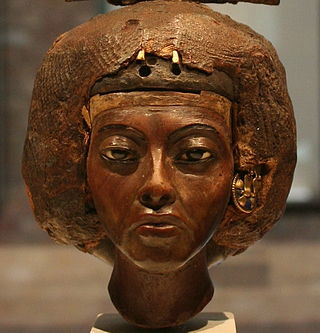
Tiye was the Great Royal Wife of the Egyptian pharaoh Amenhotep III, mother of pharaoh Akhenaten and grandmother of pharaoh Tutankhamun; her parents were Yuya and Thuya. In 2010, DNA analysis confirmed her as the mummy known as "The Elder Lady" found in the tomb of Amenhotep II (KV35) in 1898.

Amenhotep III, also known as Amenhotep the Magnificent or Amenhotep the Great and Hellenized as Amenophis III, was the ninth pharaoh of the Eighteenth Dynasty. According to different authors, he ruled Egypt from June 1386 to 1349 BC, or from June 1388 BC to December 1351 BC/1350 BC, after his father Thutmose IV died. Amenhotep was Thutmose's son by a minor wife, Mutemwiya.

Tadukhipa, in the Hurrian language Tadu-Hepa, was a princess of the Mitanni kingdom. The daughter of King Tushratta of Mitanni and his queen Juni, and niece of Artashumara. Tadukhipa's aunt Gilukhipa had married Pharaoh Amenhotep III in his 10th regnal year. Tadukhipa was to marry Amenhotep III more than two decades later.
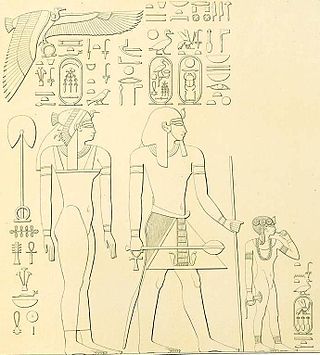
Ahmose was an Ancient Egyptian queen in the Eighteenth Dynasty. She was the Great Royal Wife of the dynasty's third pharaoh, Thutmose I, and the mother of the queen and pharaoh Hatshepsut. Her name means "Born of the Moon".

Thutmose IV was the 8th Pharaoh of the 18th Dynasty of Egypt, who ruled in approximately the 14th century BC. His prenomen or royal name, Menkheperure, means "Established in forms is Re." He was the son of Amenhotep II and Tiaa.

The New Kingdom, also referred to as the Egyptian Empire, was the ancient Egyptian nation between the 16th century BC and the 11th century BC. This period of ancient Egyptian history covers the Eighteenth, Nineteenth, and Twentieth Dynasties. Through radiocarbon dating, the establishment of the New Kingdom has been placed between 1570 BC and 1544 BC. The New Kingdom followed the Second Intermediate Period and was succeeded by the Third Intermediate Period. It was the most prosperous time for the Egyptian people and marked the peak of Egypt's power.
Mortuary temples were temples that were erected adjacent to, or in the vicinity of, royal tombs in Ancient Egypt. The temples were designed to commemorate the reign of the Pharaoh under whom they were constructed, as well as for use by the king's cult after death. Some refer to these temples as a cenotaph. These temples were also used to make sacrifices of food and animals.
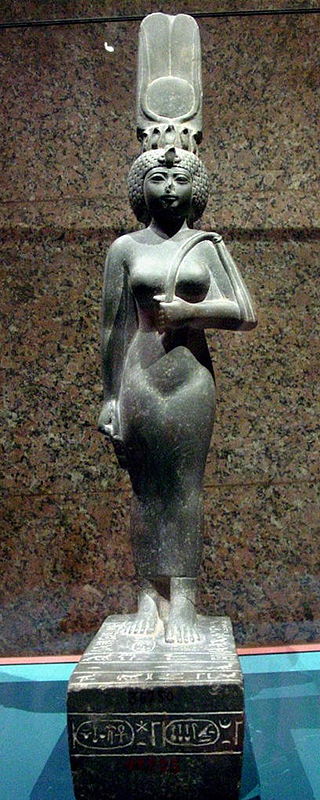
God's Wife of Amun was the highest-ranking priestess of the Amun cult, an important religious institution in ancient Egypt. The cult was centered in Thebes in Upper Egypt during the Twenty-fifth and Twenty-sixth dynasties. The office had political importance as well as religious, since the two were closely related in ancient Egypt.

The Red Chapel of Hatshepsut or the Chapelle rouge was a religious shrine in Ancient Egypt.

Great Royal Wife, or alternatively, Chief King's Wife, is the title that was used to refer to the principal wife of the pharaoh of Ancient Egypt, who served many official functions.

Thutmose was the eldest son of Pharaoh Amenhotep III and Queen Tiye, who lived during the Eighteenth Dynasty of Egypt. His early death led to the reign of Akhenaten, his younger brother—as the successor to the Egyptian throne—and the intrigues of the century leading up to Ramesses II, the start and ultimately the failure of Atenism, the Amarna letters, and the changing roles of the kingdom's powers.
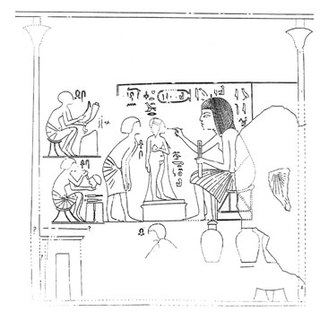
Beketaten (14th century BCE) was an ancient Egyptian princess of the 18th Dynasty. Beketaten is considered to be the youngest daughter of Pharaoh Amenhotep III and his Great Royal Wife Tiye, thus the sister of Pharaoh Akhenaten. Her name means "Handmaid of Aten".
Artatama I was a king of the Hurrian kingdom of Mitanni in the late fifteenth century BC. His reign coincided with the reigns of Egyptian pharaohs Amenhotep II and Thutmose IV. He is believed to be the son of earlier Mitanni king Shaushtatar.
Mutnofret, also rendered as Mutneferet or Mutnefert, was a queen during the Eighteenth Dynasty of Egypt. She was a secondary wife of Thutmose I and the mother of his successor Thutmose II; Thutmose I's chief wife, however, was his sister Queen Ahmose, the mother of Hatshepsut.

Tiaa or Tia'a was an ancient Egyptian queen consort during the Eighteenth Dynasty of Egypt. She was a "faceless concubine" during the time of Amenhotep II who withheld from her the title Great Royal Wife, but when her son Thutmose IV became pharaoh, he performed a revision of her status and gave her that title.
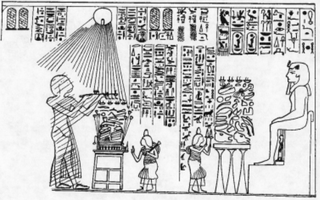
Bek or Bak was the first chief royal sculptor during the reign of Pharaoh Akhenaten. His father Men held the same position under Akhenaten's father Amenhotep III; his mother Roi was a woman from Heliopolis.

The Eighteenth Dynasty of Egypt is classified as the first dynasty of the New Kingdom of Egypt, the era in which ancient Egypt achieved the peak of its power. The Eighteenth Dynasty spanned the period from 1550/1549 to 1292 BC. This dynasty is also known as the Thutmoside Dynasty) for the four pharaohs named Thutmose.
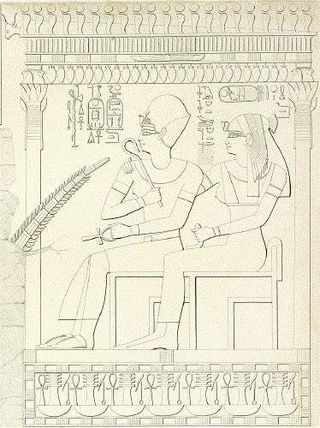
Queen Merytre-Hatshepsut was the Great Royal Wife of Pharaoh Thutmose III after the death of Queen Satiah. She was the mother of Pharaoh Amenhotep II.

Women in ancient Egypt had some special rights other women did not have in other comparable societies. They could own property and were, at court, legally equal to men. However, Ancient Egypt was a patriarchal society dominated by men. Only a few women are known to have important positions in administration, though there were female rulers and even female pharaohs. Women at the royal court gained their positions by relationship to male kings.

















